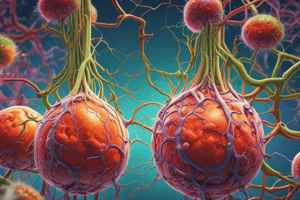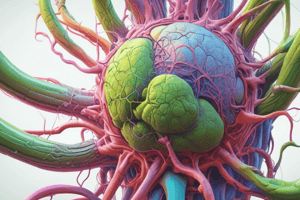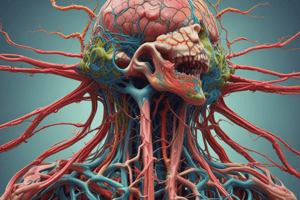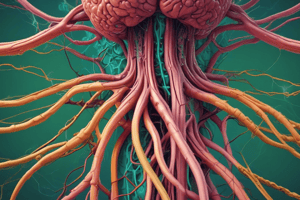Podcast
Questions and Answers
Where are lymph nodes concentrated?
Where are lymph nodes concentrated?
- Neck, groin, and armpit (correct)
- Head, hands, and feet
- Legs, arms, and abdomen
- Back, shoulders, and chest
What is the function of the spleen in the lymphatic system?
What is the function of the spleen in the lymphatic system?
- Destroys defective red blood cells and recognizes antigens (correct)
- Stores excess tissue fluid
- Produces T-lymphocytes
- Filters lymph and produces antibodies
How does lymph enter the bloodstream?
How does lymph enter the bloodstream?
- Through the pulmonary vein
- Through the aorta
- Through the left subclavian vein (correct)
- Through the carotid artery
What is the responsibility of the thymus in the lymphatic system?
What is the responsibility of the thymus in the lymphatic system?
What is the main function of lymphatic capillaries?
What is the main function of lymphatic capillaries?
What do phagocytic white blood cells do in the lymph nodes?
What do phagocytic white blood cells do in the lymph nodes?
What is the role of lymph vessels in the lymphatic system?
What is the role of lymph vessels in the lymphatic system?
What is the function of B-lymphocytes and T-lymphocytes in the lymph nodes?
What is the function of B-lymphocytes and T-lymphocytes in the lymph nodes?
Study Notes
Lymph Node Distribution
- Lymph nodes are concentrated in the neck, armpits, and groin areas.
Spleen Function
- The spleen acts as a filter for the blood, removing old, damaged red blood cells and recycling the iron content.
- It also stores red blood cells, lymphocytes, and platelets.
Lymphatic-Bloodstream Interface
- Lymph enters the bloodstream through the thoracic duct and right lymphatic duct, which empty into the subclavian veins.
Thymus Responsibility
- The thymus is responsible for the development and maturation of T-lymphocytes (T-cells).
Lymphatic Capillaries
- The main function of lymphatic capillaries is to absorb and transport fats and fatty acids from the digestive system.
Phagocytic White Blood Cells
- Phagocytic white blood cells, such as dendritic cells and macrophages, in the lymph nodes engulf and digest foreign particles, bacteria, and dead cells.
Lymph Vessels
- Lymph vessels transport lymph throughout the body, allowing for the exchange of substances between the lymph and bloodstream.
- They also provide a route for immune cells to travel to areas of the body where they are needed.
B- and T-Lymphocytes
- B-lymphocytes (B-cells) produce antibodies to fight infections, while T-lymphocytes (T-cells) directly attack infected cells.
- Both B- and T-lymphocytes are activated in the lymph nodes to mount a specific immune response to pathogens.
Studying That Suits You
Use AI to generate personalized quizzes and flashcards to suit your learning preferences.
Related Documents
Description
Test your knowledge of the structure and function of the lymphatic system with this quiz. Explore topics such as lymphatic capillaries, lymph nodes, and the role of white blood cells in filtering foreign particles.




